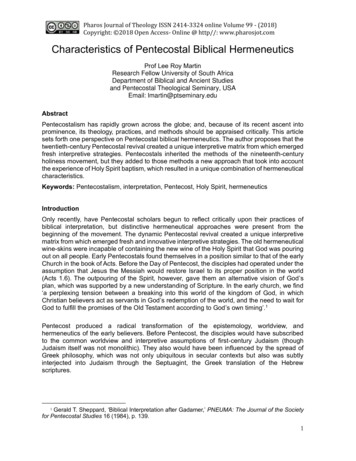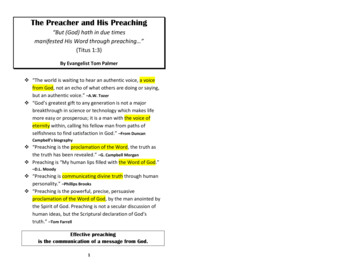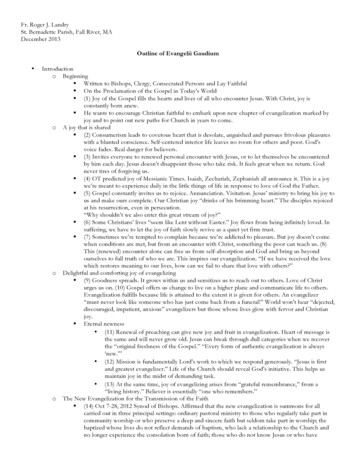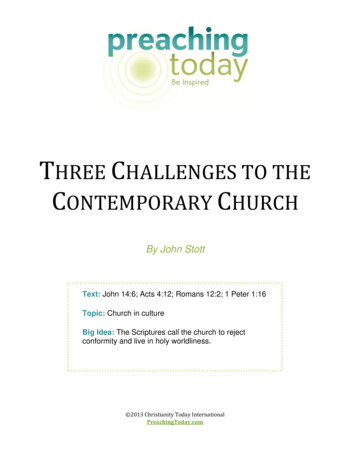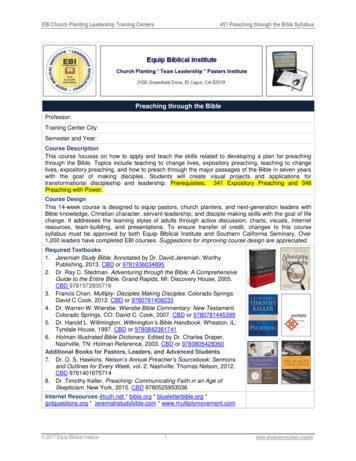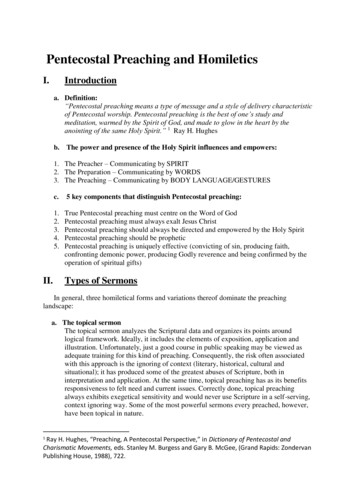
Transcription
Pentecostal Preaching and HomileticsI.Introductiona. Definition:“Pentecostal preaching means a type of message and a style of delivery characteristicof Pentecostal worship. Pentecostal preaching is the best of one’s study andmeditation, warmed by the Spirit of God, and made to glow in the heart by theanointing of the same Holy Spirit.” 1 Ray H. Hughesb.The power and presence of the Holy Spirit influences and empowers:1. The Preacher – Communicating by SPIRIT2. The Preparation – Communicating by WORDS3. The Preaching – Communicating by BODY LANGUAGE/GESTURESII.c.5 key components that distinguish Pentecostal preaching:1.2.3.4.5.True Pentecostal preaching must centre on the Word of GodPentecostal preaching must always exalt Jesus ChristPentecostal preaching should always be directed and empowered by the Holy SpiritPentecostal preaching should be propheticPentecostal preaching is uniquely effective (convicting of sin, producing faith,confronting demonic power, producing Godly reverence and being confirmed by theoperation of spiritual gifts)Types of SermonsIn general, three homiletical forms and variations thereof dominate the preachinglandscape:a. The topical sermonThe topical sermon analyzes the Scriptural data and organizes its points aroundlogical framework. Ideally, it includes the elements of exposition, application andillustration. Unfortunately, just a good course in public speaking may be viewed asadequate training for this kind of preaching. Consequently, the risk often associatedwith this approach is the ignoring of context (literary, historical, cultural andsituational); it has produced some of the greatest abuses of Scripture, both ininterpretation and application. At the same time, topical preaching has as its benefitsresponsiveness to felt need and current issues. Correctly done, topical preachingalways exhibits exegetical sensitivity and would never use Scripture in a self-serving,context ignoring way. Some of the most powerful sermons every preached, however,have been topical in nature.Ray H. Hughes, “Preaching, A Pentecostal Perspective,” in Dictionary of Pentecostal andCharismatic Movements, eds. Stanley M. Burgess and Gary B. McGee, (Grand Rapids: ZondervanPublishing House, 1988), 722.1
b. The narrative sermonThe narrative genre basically builds the sermon around a storyline or character,weaving the proclamation of eternal truth and application into its very fabric. The riskof narrative preaching can be that the preacher becomes more storyteller thancommunicator of eternal truth. Skill in weaving a good story upstages preaching theWord. Narrative preaching, however, is an approach that very effectively enables thepreacher to bridge the gap between generations and has the approach of Jesus tocommend it.c. The expository sermon.Expository preaching proclaims the message of a passage of Scripture to acontemporary audience in such a way that people hear what a passage of Scripturesays, identify with the situation it addresses, become aware of how it applies to theirlives and are led to a decision. This is the best and most powerful type of sermon andwe will concentrate on this in this course.III. Preparation of the Preacher - - -The most important factor in the preparation of sermons is the preparation ofthe preacher’s own heart.No amount of knowledge, or of learning or of natural endowments can take the placeof a fervent, humble, devoted heart which longs for more and more of Christ.Only the man who walks with God and who lives a holy life can inspire others togrow in the grace and knowledge of Christ. Such a man will spend much time insecret with Jesus, holding daily, uninterrupted, unhurried communion with Him in HisWord.The preacher must also be a man of prayer who has learned the art of holywarfare upon his knees.Like Daniel, he must have the habit of prayer and find the time, yes, make the time, topray daily and regularly in his closet.His sermons then will not be the product of mere intellectual effort but will beheaven-sent messages -- sent to him in answer to prayer.E. M. Bounds, the mighty man of prayer, said in truth, “Prayer puts the preacher’ssermon into the preacher’s heart; prayer puts the preacher’s heart into the preacher’ssermon.”But the man who is to preach the message of the Book must also be a man of theBook.He must study the Scriptures not just to get a message for his congregation. He mustlive in the Book.The Word of God must become his meat and drink. Throughout his life he must spendhours every week in diligent study of the Bible.He must saturate himself with it until it grips his heart and soul so that with Jeremiahhe may say, “His Word was in mine heart as a burning fire shut up in my bones, and Iwas weary with forbearing, and I could not stay” (Jer. 20:9).
IV. Preparation of the Preaching1. Topical Preachinga. Definition of a Topical Sermon:A topical sermon is one in which the main divisions are derived from the topic,independently of a text.This means that the-1) A Topical sermon begins with a topic or theme and that the main parts of thesermon consist of ideas which come from that topic.2) It does not require a text as the basis of its message. That is, a certain text is not thesource of the topical sermon, although it is all based on the Word of God.3) We start with a Biblical topic. The main divisions of the sermon outline must bedrawn from this Biblical topic, and each main division must be supported by aScripture reference.Example of a Topical SermonSatan’s Attack of the Family!Aim: Recognizing some aspects of his attack! (Eph. 6:10-18)A. His Goal is to Devour! (I Peter 5:8,9)B. His Desire is to Sift as Wheat! (Luke 22:31,32)C. His Method is to Build a Stronghold! (II Cor. 10:3-5)D. His Purpose is to Bring Total Bondage to Sin! (II Tim. 2:24-26)b. Unity of Thought in a Topical SermonIt will be observed from the example given above that the topical sermon contains onecentral idea. There is but one theme, not many. In a topical sermon we must limit theentire outline to the one idea contained in the topic and the aim of the message itself.c. The Various Kinds of TopicsThe Scriptures deal with every conceivable phase of human life and activity. They alsoreveal God’s purposes in grace toward men in time and in eternity. Thus the Biblecontains an inexhaustible storehouse of topics from which the preacher may obtainmaterials for topical messages suited for every occasion and condition in which menfind themselves. Through constant and diligent study of the Word of God, the man ofGod will enrich his own soul with precious nuggets of divine truth.There are many themes, such as: influences for good, little things God uses, blundersof God’s children, blessings that come through suffering, results of unbelief, factsabout prayer, meaning of prayer, methods of prayer, power of prayer, results of prayer,lies of satan, conquests of the cross, characteristics of a Christian, glories of heaven,riches of the Christian, power of God’s love, etc.d. Choice of TopicsIf we are to know the topic to select, we must seek the leading of the Lord. The choicemay be determined by the theme on which the minister is asked to speak or by thespecific occasion on which the message is to be delivered. Certain conditions within
the particular congregation may indicate the need for selecting a topic suited to thecircumstances.e. Basic PRINCIPLES for the PREPARATION of Topical Outlines!1. The main divisions should be in logical or chronological order. (Illus.)The Believer’s HopeTopic: Characteristics of the Believer’s Hope!I. It is a living hope, I Pet 1:3II. It is a saving hope, I Thess 5:8III. It is a sure hope, Heb. 6:19IV. It is a good hope, II Thess. 2:16V. It is an unseen hope, Rom. 8:24VI. It is a blessed hope, Tit 2:13VII. It is an eternal hope, Tit. 3:72. The main division may be an analysis of the topic. Each part of the outlinecontributes to the completeness of the discussion of the topic.3. The main divisions may present the various proofs of a topic.Knowing God’s WordTopic: Some values of knowing the Word of God!I. Knowing God’s Word makes one wise unto salvation, II Tim. 3:15II. Knowing God’s Word keeps us from sin, Psa. 119:11III. Knowing God’s Word produces spiritual growth, I Pet. 2:2IV. Knowing God’s Word results in successful living, Josh. 2:7-8, Psa. 14. The main divisions may treat a subject by comparison or contrast withsomething else in Scripture.An Effective Testimony!Topic: A comparison between the testimony of the believer and salt.I. Like salt, the believer’s testimony should season, Col. 4:6II. Like salt, the believer’s testimony should purify, I Thess. 4:4III. Like salt, the believer’s testimony should not lose its savor, Matt. 5:13IV. Like salt, the believer’s testimony should create thirst, I Pet. 2:125. The main divisions may be expressed by a certain word or phrase of Scripturewhich is repeated though out the outline.The Ability of God!Topic: Some Things Which God Is Able to DO!I. He is able to save, Heb 7:25II. He is able to keep, Jude 24III. He is able to help, Heb. 2:18IV. He is able to subdue, Phil. 3:21V. He is able to give grace, II Cor. 9:8VI. He is able to do beyond what we ask or think, Eph. 3:20
6. The main divisions may be supported by an identical word or phrase of Scripturethough out the outline.7. The main division may consist of a word study showing the various meanings of acertain word or words in Scripture. (Such as a study of the names of Christ, or thenames of God, etc.)f. Various ideas about Topical messages!1. The topical message is suited to the construction of the doctrinal sermon.2. Many times you may choose to work on a series of topical messages -- such as theLove of Jesus, the Face of, the Hands of, the Tears of, the Cross of, the Blood of, etc.3. A study of major subjects in a book or a group of books in the Bible will alsosuggest a series of discourses in topical form.Exercises:1. Prepare a topical outline using one of the themes or ideas listed:2. Prepare a topical outline using your own topic, support each main division withappropriate Scripture. Be careful to follow the principles suggested above.3. List seven suitable topics for evangelistic messages, and make a topical outline ofone of them.4. Find a significant word or phrase which occurs repeatedly in a book of the NewTestament and develop a topical outline from the repetitions of that word or phrase.(Such as the word, walk in Ephesians 4, 5, 6.)5. With the help of a concordance prepare a word study on the word forgive.2. Expositional PreachingBasic Principles for the Preparation of Expository Outlines!1. Any passage under consideration should be carefully studied to understand itsmeaning and to obtain the central thought of the text.2. Significant words or phrases in the text may indicate or form the main divisions of theoutline.3. The outline should be drawn from the expository unit in a chronological way.4. The important truths suggested by the passage may form the main divisions of theoutline.5. Two or three passages from various parts of Scripture may be put together to form thebasis of an expository outline.6. By means of the method of multiple approach, we may treat a passage of Scripture invarious ways and thus have two or more entirely different outlines on the same portion.7. We should, in study, note the context.8. In study we should also note the historical background of the passage, wheneverpossible.9. The details of the text should be treated properly, but not necessarily exhaustively.Don’t spend too much time on the details.10. The truths contained in the text must be related to the present day throughapplication of truths to present needs.
a. The Study Phase-Stage One – Observation Task 1: Determining the boundaries of the passage. Task 2: Identify the central idea of the passage in the writer’s own words. Task 3: Analyze how the biblical writer develops this theme in the passage. Task 4: Find the “situation clues” and “purpose clues” in the immediate andbroader context.-Stage Two – Interpretation Task 5: Write a paragraph summarizing the situation the passage addresses. Task 6: Write a paragraph synthesizing the purpose clues of the passage. Task 7: Develop a descriptive outline tracing the argument of the passage. Task 8: Engage in further study using quality resources.-Stage Three – Application Task 9: Identify how the passage applies to similar situations today.-Stage Four – Response Task 10: Personally respond to the teaching of the passage.b. The Strategy Phase Step 1: Prayerfully reflect on what you have studied.Step 2: Write a theme statement (proposition) for your sermon.Step 3: Identify the “felt need” that the passage addresses.Step 4: State clear objectives for your message.Step 5: Brainstorm with a creative team about media and drama support.Step 6: Come up with a good title and introduction.Step 7: State each point as a principle.Step 8: Explain and apply the text for each point.Step 9: Identify apt illustrations.Step 10: Prayerfully craft your conclusion and appeal.Notes for Step 2:The Proposition (or theme) of the Message or Sermon!The theme or thesis is a simple declaration of the subject which the preacher proposes todiscuss, develop, prove, or explain in the sermon. In other words, it is the sermon reduced toone sentence. The proposition contains the basic element of the theme or central thought ofthe sermon. It should be so stated as to relate it to the hearers in the form of a timeless truth.Look at Isaiah 55:7 - The theme is that God pardons sinners! Observe that the basic elementof the theme, divine pardon, is expressed in a statement which has universal application. It isa timeless truth so stated!The Importance of the Proposition!1. The proposition is the foundation of the entire structure of the sermon. The importance ofa correct proposition cannot be overestimated.2. The proposition will accurately express the main thought of the sermon.3. It clearly indicates to the congregation the course of the sermon.
Types of Propositions!1. The form most commonly used is the declarative or declaring -- a simple statementexpressing the main idea of the sermon- e.g - Christian life may be said to be a life ofdependence!2. Another type is the interrogative or using questions. The dominant idea of the sermon isput in the form of a question. We could take the sermon above and use the approach of aquestion! Asking, “Why is the Christian life said to be a life of dependence?”3. The third kind of proposition is called the hortatory (exhorting). This is employed when thepreacher’s aim is to encourage or exhort his congregation to adopt a certain course of action.(This is probably used the most.)4. The fourth kind of proposition is known as the exclamatory. (This type of thesis takes theform of an exclamation where the sermonizer desires to give special emphasis to the mainidea of his theme. For example, if he wishes to stress the blessings which the believer has inChrist as revealed in Ephesians 1:13,14, he may use an exclamation such as that shown in theoutline below.)“Supremely Blessed!”, Ephesians, chapter oneProposition: How wonderful are the blessings which we have in Christ!I. We are Chosen in Him, vs. 4II. We are Redeemed in Him, vs. 7III. We Have An Inheritance in Him, vs. 11IV. We are Sealed in Him, Vs 13Principles for the Formulation of the Proposition!1. The proposition should contain one main idea.2. The proposition should generally be expressed in the form of a timeless truth stated simplyand clearly. It should be in the form of a complete sentence. Since it is the expression of aBiblical truth, it should often be stated to suggest the idea of obligation, worthiness, ordesirability.Example: “Triumphant Living!”Text: Phil. 1:12-21Proposition: Christians can be triumphant in Christ!I. In the face of adversity, as Paul was, vs. 12-145II. In the face of opposition, as Paul was, vs. 15-19III. In the face of death, as Paul was, vs. 20-213. The proposition should be stated as concisely and clearly as possible. (Few words – muchmeaning.)4. The proposition should be connected to the main body of the discourse by questions and atransitional sentence. (Interrogatives are: Why? How? What? When? and Where?)Example: Statement -- The Christian life may be said to be a life of dependence.Interrogative -- Why is the Christian life said to be a life of dependence?Transitional sentence -- There are several reasons why the Christian life may be said to be alife of dependence.5. The proposition may be formulated by including the key word and the transitional sentencewith the statement of the thesis or aim of the message.It is best if the preacher writes out the proposition in his sermon notes. The proper place isgenerally at the end of the introduction. You are stating what your goal is, or your aim of themessage. The hearer knows where you are going, what you are seeking to accomplish in themessage although you are not sharing everything at that point.
Notes for Step 6:The Title of a Message or Sermon!The title is the expression of the specific feature to be presented in the sermon, stated in amanner which may be suitable for advertising the sermon.1. The title should be pertinent to the text or to the message.2. The title should be interesting.3. The title should be in keeping with the dignity of the pulpit.4. The title should generally be brief.5. The title may be stated in the form of either facts, questions, or exclamation.Introduction to a Message or Sermon!The introduction is the process by which the preacher endeavors to prepare the minds andsecure the interest of his hearers in the message he has to proclaim.The Purpose is -1. To secure the good will of the hearers. (The introduction then must be presented in such away as to win the favorable attention of the entire congregation if at all possible.)2. To arouse interest in the theme. (People may not seem interested at first or may bepreoccupied with other things, or indifferent to biblical truth. Other conditions may distractthem such as a poorly ventilated building, insufficient lighting,the slamming of doors, orother sounds outside.)Principles for a Good Introduction!1. It generally should be brief.2. It should be interesting. (The first few minutes of a sermon are crucial. How can westimulate interest as we begin the sermon? -- By arousing curiosity, by means of variety, bythe use of illustrations, by a captivating title, by relating the sermon to life situations. )3. It should lead to the dominant idea or central thought of the sermon or message.Proposition: The statements contained in the introduction should consist of a series ofprogressive ideas culminating in the one main idea of the message.4. It should be stated in the outline in a few brief sentences or phrases, with each successiveidea on a different line. (Long complex sentences should be avoided. They should be clear,even at just a glance, for the one bringing the message.)Example of Step 7: Consider the following comparison of the two approaches taken from amessage entitled “Thank You for Giving to the Lord” (Text: Philippians 4:10-23)Points Stated as Descriptive StatementsPoints Stated as Principles1. Their Gift: Prompted Paul’s Rejoicing (vv.10, 20)1. Giving Prompts Praise (vv. 10, 20)2. Their Gift: And an Important Lesson PaulLearned (vv. 11-13)2. Giving Helps Put Things in ProperPerspective (vv. 11-13)3. Their Gift: A Partnership in Ministry (vv.14-16)3. Giving Demonstrates Partnership inMinistry (vv. 14-16)
4. Their Gift: An Investment and More (vv.17-18)4. Giving Is a Heavenly Investment and aPleasing Sacrifice to God (vv. 17-18)5. Their Gift: Leads to a Wonderful Word ofAssurance (v. 19)5. Giving Results in a Wonderful Promise ofAssurance.Notes for Step 9: Apt IllustrationsThe speaker’s greatest asset is the listeners IMAGINATION3 tactics of Story Telling:1. PHRASES of truthCLEVER phrase – “When you come to the end of yourself you come to the beginningof God.”DEFINITIONS – “Commitment is staying true to a worthy decision long after theemotions have gone.”QUOTES – “A Bible that is falling apart usually belongs to someone who isn’t”Moody2. Word PICTURES (eg. 2 Tim 3:16 – picture of a road – Doctrine Signpost, Reproof turning 180 degrees to go right way, correction coming back on track, instruction walking with an experienced guide)3. Illustrative STORIES – listen to good story tellers, Read short stories/illustrations,increase your vocab and be more descriptive.Notes for step 10:Ten key characteristics should be evident in effective sermon conclusions: They should evidence prayer and thoughtful preparation. They should be brief and sincere. They should be prepared with the purpose of the passage in mind. They should be the logical extension of the truth of the passage. They should provide the emotional climax of the sermon. They should personalize the application – moving the sermon from second and thirdperson (“others”) to first person (“me”). They should seek a verdict based on the evidence presented in the message. They should seek a commitment from the hearer. They should be specific about what the preacher expects the audience to do at theclose of the service.
They should be sensitive to the working of the Spirit in the heart of the hearer.Exercises:1. Prepare an expository outline on I Corinthians 13:1-8, giving the title, centralthought, and main divisions of the passage.2. Prepare an expository outline on John 15:1 -8, giving the title, central thought ortheme and main divisions of the passage.3. Prepare an evangelistic, expository message from John 3:25-28, giving the title,central thought or theme, and main divisions of the passage.4. Make a biographical sermon outline on Abraham’s nephew Lot (note all theportions that deal with his life in Genesis 13, 14, and 19.) Give the title, central idea,and main divisions, and indicate the references which relate to each main division.5. Prepare an evangelistic sermon from Ephesians 2:1-9. Give the title, theme andmain divisions of the text.6. Choose your own expository unit and prepare two different expository outlines onthe same passage. Indicate the central thought and main divisions of each.7. Prepare an expository outline on I Corinthians 3:1-8, giving the title, centralthought, and main divisions of the passage. Indicate the verses which relate to eachmain division.V.The Preaching Itselfa. Overcoming Nervousness1. Be CONVINCED.2. LIVE it out.3. Get the MESSAGE in you.4. Deal with NEGATIVE ROOTS of nervousness (Pride, insecurity, fear of failureor man, lack of love and compassion for others).5. Visualize an audience of ONE.b. Presentation Tips1. PREPARE and over-PREPARE2. MEMORIZE your first 50 words.3. Stay SIMPLE4. Stay HUMBLE5. Before you go up to speak - BREATH6. Speak SLOWLY
7. Develop a greater PASSION than your FEARc. The Holy Spirit enhances the presentation of the Pentecostal preacher.- The preacher should not be bound to outline but led by Spirit.-The Spirit helps overcome distracting mannerisms and idiosyncrasies.The Spirit free preachers from the destructive self-consciousness that destroyseffective communication.-He is also able to help the preacher maintain a clear sense of objective so that freedomand flexibility do not degenerate into pointless and aimless wanderings.The Holy Spirit will enable a realistic evaluation of time so that a fully developedsermon can be preached (exercise self control - Gal 5:22-23)-There is an appropriate sense of authority that comes from the Spirit of God at workin the preacher’s life (Mt. 7:29; Mk. 1:22).-The guidance of the Holy Spirit along with the preacher’s interpersonal skills arecritical to dealing with unexpected disruptions (1 Cor 14:40)d. Important Points for effective preaching:Eye contactooLook directly into the eyes of several people around the room. Find responsivelisteners, but don’t focus exclusively on them. Don't dodge the resistant faces.Ignore unresponsive body language, but respond to looks of confusion,excitement, etc.VoiceoooYou should practice variation in tone (sharp or mellow), pitch (high or low),rate (fast or slow), and volume (loud and soft). Uniformity bores people orwears them down.Use vivid words, and find effective ways to emphasize key words. Use pause,repetition or special gestures for emphasis of important statements. Listen toother effective teachers and imitate them, without losing your own personality.Your voice should be loud enough for the person farthest away to hearcomfortably.Gestures & PostureoooDon't slump or cower. Come across relaxed, but take authority.Your gestures should be varied, appropriately aggressive, and undistracting(enhancing your content, not distracting from it)--not showy or over-dramatic.Avoid drinking unless necessary.Your facial expressions should express the full range of emotion: anger,surprise, delight, irony, pathos, compassion, etc.
oLecterns, coffee tables, etc. should be avoided in home group teachings. Theyintroduce more formality and distance between you and your audience, andthey encourage more notes.Dress should be undistracting to the audience--avoid excessive sloppiness orformality.Never disqualify yourself as a teacher or your content. Statements like, "I’m notvery good at this," or "This is not a very good outline" needlessly compromise theopportunity to impact your audience, and deflate your own confidence. You areteaching God's Word and you are God's spokesman!oHowever, you should be careful to distinguish between your own opinion andGod's Word. You should also acknowledge the complexity of certain issues.Speak both as a fellow-learner/sinner and as a prophet. Somehow, you shouldcommunicate that you have much to learn and a long way to go in your own walkwith God. This helps people to identify with you and is a way of communicatingGod’s grace. But having done this, you also need to boldly proclaim God’s Word andcall on people (as God’s mouthpiece) to respond to it.ooYour use of personal pronouns is important in achieving this balance. "We"and "I" are usually appropriate in speaking as a fellow-learner. "You" is oftenmost appropriate in speaking as God’s spokesperson.Normally, you should speak more as a fellow-learner/sinner than as a prophet.Also, you should normally speak as a fellow-learner before speaking as aprophet. And when you use yourself as an illustration, it should often be ofyour errors and sins rather than of your victories.Be sensitive to the non-Christian and the new Christian. Keep them in mind in everypart of your teaching preparation.ooooAvoid saying things like "I'm sure you all know that passage . . ." They do notknow it and will feel intimidated by this statement.Avoid undefined "Christianese"—Christian jargon or biblical terms withwhich new people are unfamiliar. If you use these terms, define themimmediately. Otherwise, they alienate new people.Don’t turn to other passages unless necessary. When turning to anotherpassage, tell your audience how to find it and allow time for them to find thepassage before you read it.Stay grace-oriented. Non-Christians and new Christians usually view theChristian life without proper understanding of or emphasis on God's grace, sounless you emphasize this, they will usually hear you through a legalistic grid.When teaching biblical ethics, stress God’s acceptance apart from our works,the Holy Spirit’s role in sanctification and ministry, biblical ethical priorities(e.g., love over ritual; sexual purity over no cussing) and the fact that God’smoral will is for our welfare and fulfillment. Having done this, be strong andunashamed in your ethical imperatives.
Use slang only if it is familiar and appropriate to your audience. Otherwise it willreduce your credibility.Avoid verbal "fat."oooAvoid extraneous material and redundancy.Don't narrate what you went through as you prepared your teaching: "So Iwondered what this word was in the Greek . . ." Tell your audience what youdiscovered, not what you went through in the process.Don’t say, "An example/illustration of this is . . . " Just give yourexample/illustration.If you blank out or goof up, go on to the next point. Resist the urge to go backover the part you messed up unless it is crucial to the teaching. You usuallyjust make the mess worse.e. The Holy Spirit leads into congregational response and ministry.- The preaching of the Word should give rise to faith and the Holy Spirit’s activityamong God’s people that provide the setting for the miraculous to occur (I Cor 12:810)- The Holy Spirit pierces hard hearts, smashes resistance, breaks down walls, opensdoors, and slips in through the smallest of crevices. He seasons and influenceseverything (Acts 2:2)
-His sermons then will not be the product of mere intellectual effort but will be heaven-sent messages -- sent to him in answer to prayer. E. M. Bounds, the mighty man of prayer, said in truth, “Prayer puts the preacher’s sermon into the preacher’s heart; prayer puts the preacher
